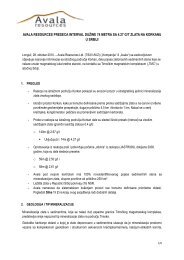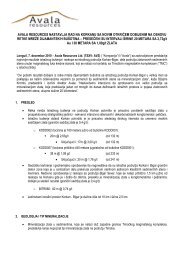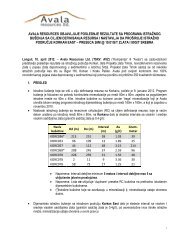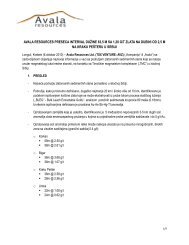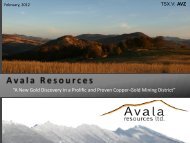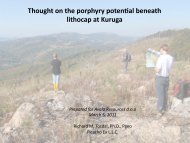Thought on the porphyry poten-al beneath lithocap at Kuruga
(KUDD-â034)? - Avala Resources Ltd.
(KUDD-â034)? - Avala Resources Ltd.
- No tags were found...
Create successful ePaper yourself
Turn your PDF publications into a flip-book with our unique Google optimized e-Paper software.
<str<strong>on</strong>g>Thought</str<strong>on</strong>g> <strong>on</strong> <strong>the</strong> <strong>porphyry</strong> <strong>poten</strong>-<strong>al</strong> <strong>bene<strong>at</strong>h</strong> <strong>lithocap</strong> <strong>at</strong> <strong>Kuruga</strong> Prepared for Av<strong>al</strong>a Resources d.o.o March 5, 2011 Richard M. Tosd<strong>al</strong>, Ph.D., Pgeo Picacho Ex L.L.C.
KUDD-‐005 KUDD-‐009 Geology of <strong>the</strong> nor<strong>the</strong>rn end of <strong>the</strong> <strong>Kuruga</strong> <strong>lithocap</strong>, Timok area, Serbia Area is underlain by a series of inferred supracrust<strong>al</strong> andesi@c volcanic, volcaniclas@c and tuffaceous rocks Extensive advanced argillic <strong>al</strong>tera@<strong>on</strong> has c<strong>on</strong>verted much of <strong>the</strong> high topography to a silica±<strong>al</strong>unite±pyrophyllite <strong>lithocap</strong>. Significant hydro<strong>the</strong>rm<strong>al</strong> breccia is present and <strong>the</strong> surface and in <strong>the</strong> historic<strong>al</strong> drilling. KUDD-‐034 3 drill holes were examined; KUDD-‐005 and KUDD-‐009 were drilled <strong>on</strong> <strong>the</strong> north into <strong>the</strong> miner<strong>al</strong>ized part of a breccia complex; KUDD-‐034 explored <strong>the</strong> <strong>poten</strong>@<strong>al</strong> for a deep <strong>porphyry</strong> Cu system <strong>on</strong> <strong>the</strong> SW corner of <strong>the</strong> area. Map courtesy of Ivan Strambanovic, Av<strong>al</strong>a Resources, March 2011
Sillitoe, 2010Wh<strong>at</strong> is seen in <strong>the</strong> <strong>Kuruga</strong> deep drill hole (KUDD-‐034)? Quartz – pyrophyllite?-‐kaolinite (supergene) <strong>at</strong> 33m Serici@zed gusano textured qtz-‐pyrophyrllite rock @ 57m
Sillitoe, 2010<strong>Kuruga</strong> KUDD-‐034 Chlorite-‐sericite pyrite overprint <strong>on</strong> 2 nd bio@te-‐magne@te @288 m Anhydrite-‐pyrite vein with bleached chlorite-‐bearing selvage @330m
Sillitoe, 2010<strong>Kuruga</strong> KUDD-‐034 Groundmass feldspar overprinted by anhydrite-‐pyrite-‐chlorite @428m Transi@<strong>on</strong> from pervasive 2 nd bio@te-‐magne@te to “un<strong>al</strong>tered” host hornblende diorite over 5 cm @460m
Sillitoe, 2010KUDD-‐034 Wh<strong>at</strong> part of a <strong>porphyry</strong> system might <strong>the</strong> deep <strong>Kuruga</strong> drill hole KUDD-‐034 have encountered? From top to ~462 m depth, <strong>the</strong> drill hole passed through rocks showing <strong>the</strong> typic<strong>al</strong> hydro<strong>the</strong>rm<strong>al</strong> silic<strong>at</strong>e <strong>al</strong>tera@<strong>on</strong> assemblage characteris@c of a <strong>porphyry</strong> Cu hydro<strong>the</strong>rm<strong>al</strong> system. However, <strong>the</strong>re was a remarkable lack of quartz veins as well as Cu-‐Fe sulfide miner<strong>al</strong>s. The over<strong>al</strong>l grade is likely low, perhaps in <strong>the</strong> 0.1+% Cu from <strong>the</strong> serici@c z<strong>on</strong>e through <strong>the</strong> K silic<strong>at</strong>e (potassic) <strong>al</strong>tera@<strong>on</strong> z<strong>on</strong>e. Pyrite where present is replacing Fe-‐bearing miner<strong>al</strong>s (2 nd bio@te and magne@te) th<strong>at</strong> form a pervasive replacement of mafic phases as well as veins Pyrite is <strong>al</strong>so associ<strong>at</strong>ed with anhydrite. The transi@<strong>on</strong> in <strong>the</strong> drill core from intensely <strong>al</strong>tered to <strong>al</strong>most un<strong>al</strong>tered is very sharp (over 5 cm); sharp l<strong>at</strong>er<strong>al</strong> gradients are expected as hydro<strong>the</strong>rm<strong>al</strong> fluid flow <strong>on</strong> <strong>the</strong> margins will be largely ver@c<strong>al</strong> and in <strong>the</strong> case of <strong>the</strong> drill hole based <strong>on</strong> grain boundary diffusi<strong>on</strong> due to <strong>the</strong> lack of significant veins. Taking <strong>al</strong>l <strong>the</strong> observa@<strong>on</strong>s suggests th<strong>at</strong> <strong>the</strong> drill hole KUDD-‐034 may have just cut <strong>the</strong> pervasive <strong>al</strong>tera@<strong>on</strong> th<strong>at</strong> extend outside <strong>the</strong> Cu shell (dashed line <strong>on</strong> carto<strong>on</strong> to lej).
Loca-<strong>on</strong> of KUDD-‐034 with respect to soil Mo geochemistry Molybdenum forms a low grade shell (9 ppm KUDD-‐034 Drill hole was collared <strong>at</strong> <strong>the</strong> sou<strong>the</strong>rn end of <strong>the</strong> area of anom<strong>al</strong>ous Mo and oriented easterly (shown approxim<strong>at</strong>ely in p<strong>al</strong>e green). Collec@vely, <strong>the</strong> soil geochemistry and <strong>the</strong> rocks in <strong>the</strong> drill hole suggest th<strong>at</strong> <strong>the</strong> main por@<strong>on</strong> of a <strong>poten</strong>@<strong>al</strong>ly miner<strong>al</strong>ized <strong>porphyry</strong> may lie to <strong>the</strong> north of <strong>the</strong> KUDD-‐034. Map provided by Ivan Strambanovic, Av<strong>al</strong>a Resources, 2011
An<strong>at</strong>omy of a hydro<strong>the</strong>rm<strong>al</strong> breccia In gener<strong>al</strong>, hydro<strong>the</strong>rm<strong>al</strong> breccia show systema@c facies. There is a core of highly brecci<strong>at</strong>ed m<strong>at</strong>eri<strong>al</strong>. Where fluidiza@<strong>on</strong> has been intense, <strong>the</strong> m<strong>at</strong>rix c<strong>on</strong>sists of rock flour (finely milled rock) with clasts of varying sizes. In a single stage breccia, clast sizes increase in size and angularity toward <strong>the</strong> margin. Rocks immedi<strong>at</strong>ely outside of <strong>the</strong> breccia are crackled, th<strong>at</strong> is fractured in place and essen@<strong>al</strong>ly can be fit toge<strong>the</strong>r as a jig-‐saw. Inter-‐clast displacement and rounding increases toward <strong>the</strong> breccia. Mul@-‐stage breccia have complex overprin@ng facies from <strong>the</strong> subsequent events. Breccia nucle<strong>at</strong>e <strong>at</strong> depth and propag<strong>at</strong>e upward un@l <strong>the</strong> energy is dissip<strong>at</strong>ed, <strong>the</strong>reby forming c<strong>on</strong>ic<strong>al</strong> body. The roof rocks are cut by fingers of crackle breccia to rock flour breccia which represent <strong>the</strong> upward propaga@<strong>on</strong> of <strong>the</strong> larger body. Areas of maximum permeability are <strong>al</strong><strong>on</strong>g breccia margins; complex when mul@ple breccia bodies present. Where <strong>the</strong>y breach <strong>the</strong> surface, <strong>the</strong>y form dis@nc@ve volcanic-‐like fe<strong>at</strong>ures (see next slide)
An<strong>at</strong>omy of a hydro<strong>the</strong>rm<strong>al</strong> breccia th<strong>at</strong> vented to <strong>the</strong> surface Hydro<strong>the</strong>rm<strong>al</strong> breccias th<strong>at</strong> breach <strong>the</strong> surface some@mes are c<strong>al</strong>led di<strong>at</strong>remes. However th<strong>at</strong> term is largely reserved to breccias formed from magma@c or phre<strong>at</strong>o-‐magma@c processes whereby magma expands c<strong>at</strong>astrophic<strong>al</strong>ly to excav<strong>at</strong>e a c<strong>on</strong>ic<strong>al</strong> cr<strong>at</strong>er. In hydro<strong>the</strong>rm<strong>al</strong> and magma@c-‐rel<strong>at</strong>ed breccias, <strong>the</strong> excav<strong>at</strong>e c<strong>on</strong>e is filled with m<strong>at</strong>eri<strong>al</strong> th<strong>at</strong> was not ejected and th<strong>at</strong> f<strong>al</strong>ls back into <strong>the</strong> cr<strong>at</strong>er. Breccia facies are similar to those in hydro<strong>the</strong>rm<strong>al</strong> breccias but in magma@c breccias <strong>the</strong>re is juvenile m<strong>at</strong>eri<strong>al</strong> in <strong>the</strong> form of irregular ameboid<strong>al</strong> shaped clasts. Permeability will be gre<strong>at</strong>est <strong>al</strong><strong>on</strong>g <strong>the</strong> breccia margins, or where mul@ple breccia@<strong>on</strong> events are superposed. The cri@c<strong>al</strong> criteria required to dis@nguish interac@<strong>on</strong> with magma is <strong>the</strong> presence of <strong>the</strong> juvenile clasts.
KUDD-‐009 KUDD-‐ 005 <strong>Kuruga</strong> breccia facies placed in c<strong>on</strong>text of simple hydro<strong>the</strong>rm<strong>al</strong> breccia Clas@c rock with 0.5 ppm Au; KUDD-‐009 Tuffaceous horiz<strong>on</strong> @32m; KUDD-‐009
KUDD-‐009 KUDD-‐ 005 Auriferous crackle brecca forming feeder to overlying porous sediments; KUDD-‐009 Low Au grade cap over rock flour m<strong>at</strong>rix breccia; KUDD-‐009 @155 m
KUDD-‐009 Margin<strong>al</strong> crackle breccia; KUDD-‐005 @ 23m with 1.93 ppm Au KUDD-‐ 005 Alunite cemented rock flour breccia; KUDD-‐005 @ 195m
KUDD-‐009 KUDD-‐ 005 Pyprite-‐enargite cemente breccia margin; KUDD-‐005 @ 70 m Mul@ple rebreccia@<strong>on</strong> with pyrite±enargite replacement of youngest rock flour; KUDD-‐005 @ 225 m
KUDD-‐009 Host Rocks to breccia KUDD-‐ 005 Gusano (worm) texture in host rock — appears to be similar to many of <strong>the</strong> siliceous clasts in <strong>the</strong> hydro<strong>the</strong>rm<strong>al</strong> breccia Relict igneous texture in rare clast sugges@ng breccia cuts plagioclase and hornblende phyric rocks <strong>at</strong> depth
Wh<strong>at</strong> type of breccia underlies <strong>the</strong> nor<strong>the</strong>rn part of <strong>the</strong> <strong>Kuruga</strong> property? Insufficient knowledge is available regarding <strong>the</strong> origin<strong>al</strong> style of breccia th<strong>at</strong> forms <strong>the</strong> nor<strong>the</strong>rn part of <strong>Kuruga</strong>. Drill hole KUDD-‐009 appears to have drilled into <strong>the</strong> top of a breccia body, whereas KUDD-‐005 was collared within a breccia margin. The laqer drill hole was collared <strong>at</strong> higher eleva@<strong>on</strong>s, and shows evidence of mul@stage breccia@<strong>on</strong>. An important observa@<strong>on</strong> is th<strong>at</strong> <strong>the</strong> dominant clast in <strong>the</strong> breccia is silicified rocks, and thus essen@<strong>al</strong>ly country rocks. Hence, trea@ng <strong>the</strong> breccia as a series of nested largely hydro<strong>the</strong>rm<strong>al</strong> breccia lacking obvious magma@c input seems to be <strong>the</strong> most reas<strong>on</strong>able model <strong>at</strong> this d<strong>at</strong>e. Recognizing <strong>the</strong> mul@stage evolu@<strong>on</strong> of <strong>the</strong> breccia <strong>poten</strong>@<strong>al</strong>ly is important, and should be clarified as it may play a role in miner<strong>al</strong>iza@<strong>on</strong>.
Some c<strong>on</strong>cluding thoughts 1. Clearly <strong>the</strong>re is evidence for c<strong>on</strong>siderable hydro<strong>the</strong>rm<strong>al</strong> ac@vity <strong>at</strong> <strong>Kuruga</strong>. There is a deep <strong>porphyry</strong> evident as well as extensive hydro<strong>the</strong>rm<strong>al</strong> breccia present. 2. Gold in <strong>the</strong> <strong>lithocap</strong> is str<strong>at</strong>abound within a permeable tuffaceous horiz<strong>on</strong> as well as within <strong>the</strong> crackle and jigsaw margins of <strong>the</strong> breccia. 3. Copper in <strong>the</strong> <strong>lithocap</strong> is associ<strong>at</strong>ed with a sec<strong>on</strong>d (or third?) stage of breccia@<strong>on</strong> and is associ<strong>at</strong>ed with enargite-‐pyrite cement. 4. No evidence has been seen to d<strong>at</strong>e to indic<strong>at</strong>e th<strong>at</strong> <strong>the</strong> breccias have a magma@c comp<strong>on</strong>ent. If this is true, <strong>the</strong>n <strong>the</strong>y represent <strong>the</strong> c<strong>at</strong>astrophic volume expansi<strong>on</strong> of <strong>the</strong> hydro<strong>the</strong>rm<strong>al</strong> fluid. If this is true, <strong>the</strong>re is no need for <strong>the</strong>m to be loc<strong>at</strong>ed over <strong>the</strong> top of a <strong>porphyry</strong>-‐style intrusi<strong>on</strong>. Instead, <strong>the</strong>y can be l<strong>at</strong>er<strong>al</strong> to <strong>the</strong> intrusive center. 5. The evidence for intense and pervasive K-‐silic<strong>at</strong>e <strong>al</strong>tera@<strong>on</strong> in <strong>the</strong> deep drill demands a <strong>porphyry</strong> center <strong>at</strong> depth, as would be expected. Wh<strong>at</strong> is not know is whe<strong>the</strong>r it is miner<strong>al</strong>ized as well. A drill hole into <strong>the</strong> main part of <strong>the</strong> likely <strong>porphyry</strong> is warranted. 6. Judging from <strong>the</strong> depth of sulfide in drill core and in <strong>the</strong> nearby Lipa system, <strong>the</strong> sulfide in <strong>the</strong> <strong>porphyry</strong> center is likely to begin around depths of 650 m RL, and extend to depth. This depth approxim<strong>at</strong>ely corresp<strong>on</strong>ds to <strong>the</strong> depth of extensive and not overprinted K silic<strong>at</strong>e <strong>al</strong>tera@<strong>on</strong> in KUDD-‐034.




